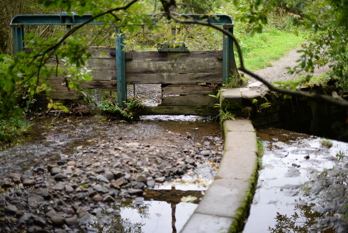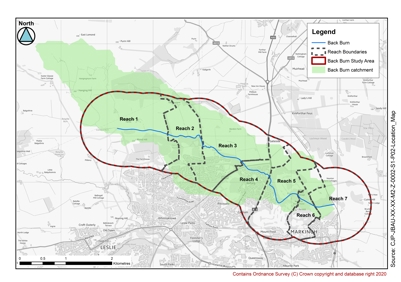Why restore the Back Burn?
 The Back Burn has been affected by many man-made changes over time. These include artificial narrowing and straightening of the burn with gabions (wire baskets filled with stones) and walls, as well as barriers within the burn, such as weirs.
The Back Burn has been affected by many man-made changes over time. These include artificial narrowing and straightening of the burn with gabions (wire baskets filled with stones) and walls, as well as barriers within the burn, such as weirs.
Restoring water courses to a more natural condition can bring many benefits, helping to:
- provide a space for local people to enjoy;
- improve local resilience to climate change;
- support biodiversity;
- reduce flood risk, for instance through natural flood management;
- gain space for nature in a more urban environment.
What is the aim of the project?
To investigate the potential to restore 5.8 kilometres of the Back Burn to a more natural state between Rhind Hill in the Lomond Hills and Newton, north of Markinch. We are also looking to improve local biodiversity and develop the area with local communities.

Who is undertaking this project?
In conjunction with other initiatives in the Leven Programme, this project has been commissioned by Fife Council and the Scottish Environment Protection Agency (SEPA), supported initially with funding from the Water Environment Fund (WEF).
Fife Coast and Countryside Trust (FCCT) are managing the project on behalf of Fife Council and are working with JBA Consulting to develop restoration options that can be shared with the local community for their feedback and then taken forward together as the project progresses.
What is happening at the moment?
We are in the design stage of the project and have carried out surveys, research and reviewed information gathered about the current state of Back Burn. This information has been pulled together into options for potential improvement work that is being shared with local landowners and technical stakeholders.
Click here to view information and maps showing these proposed improvements. We hope to start the improvement works in 2024 subject to funding which is currently being sought.
How will the community be involved?
Working with the local community is a key element of this project and we are keen to engage with the community, landowners and technical specialists so that their knowledge and thoughts can be used to inform and shape the project as it progresses.
In the coming year as the project progresses, we hope to work with local community groups and schools to undertake a range of activities to ensure that local people are involved in improving the river environment and surrounding area.
Explore the proposed improvements which were shared with the public in November 2023 to hear their views. Once all responses have been assessed and taken on board, we will share how this has shaped the proposals going forward.